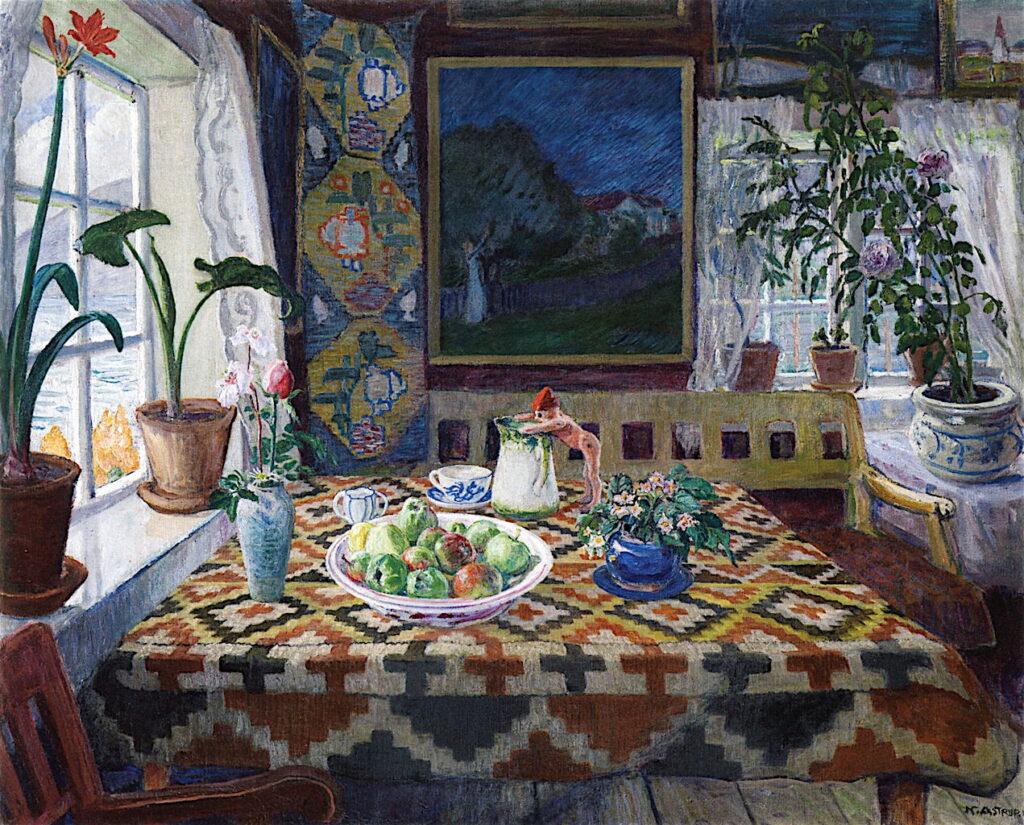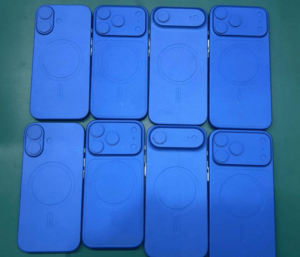Interiors by design: Introduction to a new painting series

Under the academies that dominated painting as an art during the seventeenth and subsequent centuries, paintings were distinguished in genres. These consisted of history, portraits, genre (scenes of everyday life), landscapes, animals and still life. These gave rise to a twisted system of aesthetics that assigned greater artistic merit to a formulaic depiction of classical myth, than any landscape painting. The established genres were constraints that were quickly outgrown, as I’m going to examine in this new series looking at paintings of interiors.
Painting the inside of a house first flourished during the Dutch Golden Age, as a novel genre to appeal to collectors. Initially, most included some figures and were conveniently classed as genre works, but their object of interest increasingly lay in the room and its furnishings, as a still life on a grander scale.
Gerard ter Borch (1617–1681), Three Figures Conversing in an Interior (Paternal Admonition) (c 1653-55), oil on canvas, 71 x 73 cm, Rijksmuseum Amsterdam, Amsterdam, The Netherlands. Wikimedia Commons.
Three Figures Conversing in an Interior is one of Gerard ter Borch’s narrative interiors, more popularly known as Paternal Admonition (c 1653-55). Standing with her back to us, wearing a plush going-out dress, is the daughter. To her left is a table, on which there is a small reading stand with books, almost certainly including a Bible.
Her parents are young, and they too are fashionably dressed. Her mother appears to be drinking from a glass, but her father is at the very least cautioning his daughter, if not giving her a thorough dressing-down. He wears a sword at his side. Behind them is a large bed, and to the right the family dog looks on from the gloom.
Interiors reached their height in the few brilliant paintings of Jan Vermeer.
Johannes Vermeer (1632–1675), Young Woman with a Water Pitcher (c 1662-64), oil on canvas, 45.7 x 40.6 cm, The Metropolitan Museum of Art, New York, NY. Wikimedia Commons.
Vermeer’s better-lit Young Woman with a Water Pitcher from about 1662-64 is a good example of this change in emphasis. The viewer’s attention is diverted from this anonymous young woman engaged in mundane activity, to her surroundings, the open chest on the table, the map on the wall behind her, and the play of the light coming in through the window.
Genre and interiors went into decline, before becoming more popular again in the nineteenth century, particularly in works aimed more at the less affluent.
Matthäus Kern (1801–1852), A Study Interior at St. Polten (1837), brush and watercolor on white wove paper, dimensions not known, Cooper Hewitt, Smithsonian Design Museum, New York, NY. Wikimedia Commons.
The middle classes were able to indulge in a few paintings and framed prints of their own, although most would have been family portraits rather than anything of greater aesthetic or cultural value. Matthäus Kern’s watercolour showing A Study Interior at St. Polten (1837) gives an idea of what might have been expected among the middle class, perhaps.
Narrative painting started to turn away from classical themes, and became framed around open-ended narrative and ‘problem pictures’ to challenge their reading.
Edgar Degas (1834–1917), Interior (‘The Rape’) (1868-9), oil on canvas, 81.3 x 114.3 cm, Philadelphia Museum of Art, Philadelphia, PA. Wikimedia Commons.
Edgar Degas’ Interior (1868-9), also known as The Rape, appears strongly narrative, but has so far defied all attempts to produce a reading consistent with its details. A man and a woman are in a bedroom together. She is at the left, partly kneeling down, facing to the left, and partially (un)dressed. He is at the right, fully dressed in street clothes, standing in front of the door, with his hands thrust deep into his trouser pockets.
The woman’s outer clothing is placed at the foot of the bed, and her corset has been hurriedly or carelessly cast onto the floor beside the bed. She clearly arrived in the room before the man, removed her outer clothing, and at some stage started to undress further, halting when she was down to her shift or chemise. Alternatively, she may have undressed completely, and at this moment have dressed again as far as her chemise.
Just behind the woman is a small occasional table, on which there is a table-lamp and a small open suitcase. Some of the contents of the suitcase rest over its edge. In front of it, on the table top, is a small pair of scissors and other items from a small clothes repair kit or ‘housewife’. There’s a wealth of detail that can fuel many different accounts of what is going on in this small room.
Interiors became sufficiently established by the late nineteenth century that they were widely exhibited.
Anna Alma-Tadema (1867–1943), The Drawing Room, Townshend House (1885), watercolor, pen and Indian ink over pencil on cardboard, 27.2 × 18.7 cm, Royal Academy of Arts, London. Wikimedia Commons.
Anna Alma-Tadema’s small watercolour of The Drawing Room, Townshend House, painted in 1885, demonstrates her skills at depicting surface light and texture. This painting was exhibited at the World’s Columbian Exposition in Chicago, in 1893, a remarkable achievement for someone who was only eighteen at the time that it was painted.
Interiors became popular among those in the avant garde, including Neo-Impressionists like Maximilien Luce.
Maximilien Luce (1858–1941), Morning, Interior (1890), oil on canvas, 64.8 × 81 cm, The Metropolitan Museum of Art (bequeathed by Miss Adelaide Milton de Groot (1876–1967)), New York, NY. Courtesy of Metropolitan Museum of Art, via Wikimedia Commons.
Morning, Interior (1890) is one of Luce’s best-known Divisionist paintings from the late nineteenth century. Although it adheres to the technique of applying small marks of contrasting colours to build the image, Luce’s marks are less mechanical than those seen, for example, in Seurat’s paintings. In places they become more gestural and varied, particularly in highlights.
Nordic art adopted the interior with enthusiasm, and the skills of some of its finest painters.
Harriet Backer (1845–1932) Gamlestua på Kolbotn (Old Living Room at Kolbotn) (1896), oil on canvas, 61.5 x 83.5 cm, Nasjonalgalleriet, Oslo. Wikimedia Commons.
Harriet Backer’s Gamlestua på Kolbotn (Old Living Room at Kolbotn) from 1896 is an intimate view of a friends’ living room on their farm in Østerdalen, Norway. Hulda and Arne Garborg are seen, sat at the table, with Arne holding his fiddle. Behind them are paintings, among them two landscapes painted by Backer’s friend Kitty Kielland.
Vilhelm Hammershøi (1864–1916), A Room in the Artist’s Home in Strandgade, Copenhagen, with the Artist’s Wife (1901), oil on canvas, 46.5 x 52 cm, Statens Museum for Kunst (Den Kongelige Malerisamling), Copenhagen, Denmark. Wikimedia Commons.
Some came to specialise in distinctive interiors, such as the Danish painter Vilhelm Hammershøi. His Room in the Artist’s Home in Strandgade, Copenhagen, with the Artist’s Wife from 1901 is typical of his explorations of light in rooms that effectively became large still lifes.
Harriet Backer (1845–1932), Thorvald Boecks bibliotek (Thorvald Boeck’s Library) (1902), oil on canvas, 94.5 x 89 cm, Nasjonalgalleriet, Oslo. The Athenaeum.
Thorvald Boecks bibliotek (Thorvald Boeck’s Library) (1902) is one of Backer’s few interiors that’s devoid of people, here replaced by books from floor to ceiling. The intricate detail of their many spines, furniture, and other decorations contrasts markedly with the bare floorboards in the foreground.
In France, the former Nabi artist Félix Vallotton painted a series of enigmatic interiors in the early years of the twentieth century.
Félix Vallotton (1865–1925), Interior with the Back of a Woman in Red (1903), oil on canvas, 93 x 71 cm, Kunsthaus Zürich, Zürich, Switzerland. Wikimedia Commons.
His Interior with the Back of a Woman in Red from 1903 develops the framing effect of multiple sets of doors, drawing the eye deeper towards the distant bedroom. The woman wearing a red dress looks away, her skirts swept back as if she has been moving towards the three steps dividing the space into foreground and background. There are tantalising glimpses of detail on the way: discarded fabric on a settee, clothing on a chair in the next room, and half of a double bed with a bedside lamp in the distance.
In Britain, members of the Camden Town Group led by Walter Sickert headed in a different direction.
Spencer Gore (1878–1914), The Gas Cooker (1913), oil on canvas, 73 x 36.8 cm, The Tate Gallery (Presented by the Trustees of the Chantrey Bequest 1962), London. © The Tate Gallery and Photographic Rights © Tate (2016), CC-BY-NC-ND 3.0 (Unported), https://www.tate.org.uk/art/artworks/gore-the-gas-cooker-t00496
Alongside others in the group, Spencer Gore painted mundane domestic interiors such as The Gas Cooker (1913), showing his wife Mollie in the tiny kitchen of their flat in Houghton Place in London.
Nikolai Astrup (1880–1928), Interior Still Life: Living Room at Sandalstrand (c 1921), oil on board, 81.9 x 100.4 cm, Private collection. The Athenaeum.
In Norway, Nikolai Astrup, a former pupil of Harriet Backer, provided the occasional peek into his domestic life. Interior Still Life: Living Room at Sandalstrand (c 1921) shows his family home, with a tapestry hanging in the corner, an unidentified painting on the wall, potted plants, a bowl of fruit, and an articulated wooden figure leaning against a pitcher of milk.
I hope these paintings have whetted your appetite for the rest of this series, which starts next week with the Dutch Golden Age.

